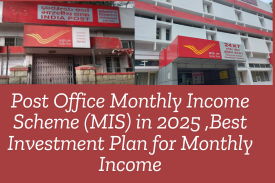Post Office Monthly Income Scheme (MIS) – Interest Rates and Key Features in 2025

The Government of India has released the latest interest rates for all post office savings schemes for the first quarter of 2025 (January to March). These rates are revised quarterly, ensuring stability for the given period. One such scheme that offers a fixed monthly income is the Post Office Monthly Income Scheme (MIS). This article discusses its features, benefits, limitations, and whether it is a suitable investment option.
What is the Post Office Monthly Income Scheme (MIS)?
The Post Office MIS is a fixed-income investment scheme that allows individuals to deposit a lump sum amount and receive a fixed monthly payout. At the end of the tenure, the principal amount is returned to the investor. Since the scheme is backed by the government, it carries minimal risk.
Eligibility and Investment Limits
- Only Indian citizens can invest in this scheme. NRIs are not eligible.
- The minimum investment amount is ₹1,500.
- The maximum limit for individual investors is ₹9 lakh (previously ₹4.5 lakh in 2023)
- Minors above 10 years of age can invest, but withdrawals are only allowed after they turn 18.
Interest Rate for 2025
The interest rate for the first quarter of 2025 is 7.4% per annum. This rate has remained unchanged since January 2023. Compared to bank fixed deposits (FDs), which offer rates between 6.5% and 7.5%, this scheme provides competitive returns with the added security of a government guarantee.
Key Features of the Scheme
- Tenure: The scheme has a lock-in period of 5 years.
- Interest Payout: Monthly interest is credited directly to the investor’s account.
- No TDS Deduction: Unlike bank FDs, the interest earned is not subject to TDS.
- Guaranteed Returns: The investment is fully backed by the Government of India.
- Fixed Interest Rate: Once invested, the interest rate remains the same throughout the tenure.
Withdrawal and Premature Closure Rules
- Before 1 year: No withdrawal is allowed.
- Between 1 to 3 years: A 2% penalty on the principal amount applies.
- Between 3 to 5 years: A 1% penalty is applicable.
- If the depositor does not withdraw the maturity amount after 5 years, it continues to earn a reduced interest rate of 3-4% per annum for the next 2 years.
Tax Implications
- While no TDS is deducted, the interest earned is still taxable under the investor’s income tax slab.
- Unlike tax-saving FDs, there is no tax exemption under Section 80C.
Comparison with Bank Fixed Deposits
- Risk Factor: Bank FDs are insured only up to ₹5 lakh by the RBI’s DICGC insurance, while Post Office MIS has a full government guarantee.
- Interest Rates: Small finance banks may offer higher rates (8-9%), but they carry higher risk compared to Post Office MIS.
- Taxation: Both investments are subject to income tax, but FDs involve TDS deductions, whereas Post Office MIS does not.
What Happens If the Depositor Dies?
- In a single account, the nominee must close the account and will receive the full amount with interest.
- In a joint account, the account continues with the surviving account holder.
Should You Invest in Post Office MIS?
- If you seek safety and fixed monthly income, this scheme is a reliable choice.
- If you are in a higher tax bracket (20-30%), bank FDs with tax-saving options might be more beneficial.
- For long-term wealth creation, equity-linked savings schemes (ELSS) or mutual funds may offer better returns.
- If your investment amount exceeds ₹5 lakh, Post Office MIS provides better security than bank FDs.
How to Invest?
- Visit your nearest post office and collect the application form.
- Submit two passport-size photos, ID proof, address proof, and a nomination form.
- Provide a cheque for the investment amount.
- Forms can be downloaded online, but submission must be done at the post office.
Conclusion
The Post Office Monthly Income Scheme is a low-risk investment option suitable for those looking for stable monthly returns. While it does not offer high returns like small finance banks, it provides complete security backed by the Government of India. Investors should consider their risk appetite and tax liabilities before investing in this scheme.